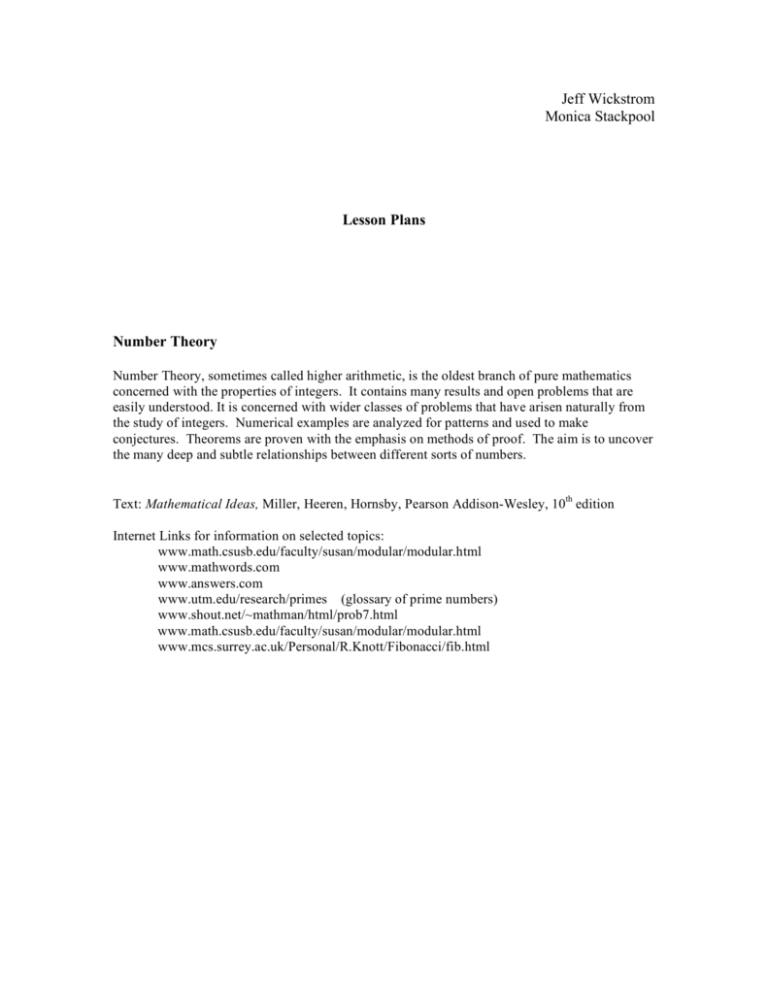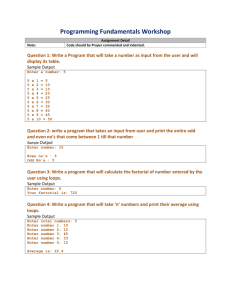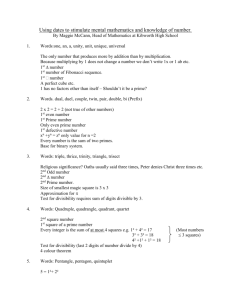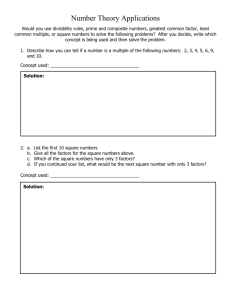
Jeff Wickstrom
Monica Stackpool
Lesson Plans
Number Theory
Number Theory, sometimes called higher arithmetic, is the oldest branch of pure mathematics
concerned with the properties of integers. It contains many results and open problems that are
easily understood. It is concerned with wider classes of problems that have arisen naturally from
the study of integers. Numerical examples are analyzed for patterns and used to make
conjectures. Theorems are proven with the emphasis on methods of proof. The aim is to uncover
the many deep and subtle relationships between different sorts of numbers.
Text: Mathematical Ideas, Miller, Heeren, Hornsby, Pearson Addison-Wesley, 10th edition
Internet Links for information on selected topics:
www.math.csusb.edu/faculty/susan/modular/modular.html
www.mathwords.com
www.answers.com
www.utm.edu/research/primes (glossary of prime numbers)
www.shout.net/~mathman/html/prob7.html
www.math.csusb.edu/faculty/susan/modular/modular.html
www.mcs.surrey.ac.uk/Personal/R.Knott/Fibonacci/fib.html
Day One and Two
Pre-Test (True/False test)
Number Theory
Pre-Test
Name
Circle your response to the following True/False questions.
True/False
1. No two prime numbers differ by one.
True/False
2. There are infinitely many prime numbers.
True/False
3. If a natural number is divisible by 3, then it must be divisible by 9.
True/False
4. If p and q are different primes, 1 is their greatest common factor and pq
is their least common multiple.
True/False
5. 93 is a composite number.
True/False
6. The prime Factorization of 24 is 1,2,3,4,6,8,12 and 24.
True/False
7. The number 6 is an abundant number.
True/False
8. There are no known odd perfect numbers.
True/False
9. Goldbach’s conjecture for the number 8 is verified by the equation
8 = 7 + 1.
True/False
10. The 5th Fibonacci Number is 25.
True/False
11. The GCF of 16 and 24 is 8.
True/False
12. The LCM of 16 and 24 is 8.
True/False
13. In 12-hour clock arithmetic 10 + 3 = 13.
True/False
14. 5
True/False
15. The exact value of the Golden Ratio is 1.618.
True/False
16. There are infinitely many Mersenne Prime numbers.
True/False
17. Every odd prime can be expressed as the difference of two squares in
one and only one way.
2(mod 7)
Reading assignment: pp. 196-203
Topics:
1. Prime Numbers
a. Definition of a Prime Number
b. Sieve of Eratosthenes
c. Mersenne Primes
2. Composite Numbers
a. Definition of a Composite Number
b. Divisibility
c. Divisibility Tests
d. Fundamental Theorem of Arithmetic
Allotted Time: Two 50-minute classes
Students will be able to understand the definitions of a prime and composite number. By
having the students create their own Sieve of Eratosthenes, they will systematically
construct a table of prime numbers through a designated number. Students will receive a
handout of numbers that will allow them to go through the process of finding the primes.
Special forms of prime numbers will be researched using Mersenne primes. Students will
use any means to research the Mersenne primes. The use of the divisibility tests will
determine whether a natural number is divisible by another natural number. Students will
be given the Division Algorithm (A=Bq + r) to check and prove divisibility tests and why
they work. Students will explore a large number (34,218,754,395,448) and will utilize
the divisibility tests to determine its divisibility from 2-12. The Fundamental Theorem of
Arithmetic (Unique Factorization Theorem) will show the relationship between prime
and composite numbers. An assignment will allow students to research the most current
Mersenne Prime Number.
Day Three and Four
Introductory Activity: Show video, “The Proof” by Nova.
Reading assignment: pp. 206-209
Topics:
1. Prime Number Theory Topics
a. Goldbach’s Conjecture
b. Twin Primes
c. Mersenne Primes
d. Fermat’s Primes
2. Non-prime Number Theory Topics
a. Pythagorean Theorem
aa. Fermat’s Last Theorem
b. Perfect Numbers
c. Deficient and Abundant Numbers
d. Weird Numbers
e. Amicable or Friendly Numbers
Allotted Time: Two 50-minute classes
Students will view the video “The Proof” by Nova and create a summary. Questions that
will be answered by the students will include Who, What, Why, and When. Students will
discuss in groups of three or four the relevance of the video; connect Wiles’ passion to
their own experiences. In these same groups, they will share their research on the
Mersenne Primes. Students will explore selected topics from Number Theory. Examples
given will help explain each of the topics. Students will look at the uniqueness of each
type of number theory topic. They will explore where these topics are in everyday life.
To begin this exploration, students will look at a set of numbers. They will find as many
different ways to express each number. For example the number 24 can be expressed as
20 + 4 or 2•2•2•3 or there are 24 cans of soda in a case. The set of numbers are 28, 12,
10, 220, 284, 18, and 3. Students will put their results on the board and begin to look at
the relationships between the numbers. At this time, the definitions will be attached to
the results.
Day Five and Six
Reading assignment: pp. 212-218
Topics:
1. Greatest Common Factor (GCF)
a. Listing Factors
b. Prime Factors Method (Prime Factorization use of common factors)
c. Dividing by Prime Factors Method (Simultaneously divide by common
factor)
d. Euclidean Algorithm Method (The Division Algorithm: A = Bq + r)
2. Least Common Multiple (LCM)
a. Listing Multiples
b. Prime Factors Method (Prime Factorization use of all primes to their
largest exponent)
c. Dividing by Prime Factors Method (Simultaneously divide by common
factors as well as use of remaining quotients)
d. Formula (LCM = Product of the two integers m and n divided by the
GCF of m and n)
Allotted Time: Two 50-minute classes
Students will be able to find the GCF and LCM using the four possible defined ways for
each topic. The numbers to begin the exploring of GCF and LCM are 84 and 60. The
Division Algorithm will be used to express the results. Students will use any of the
available methods to solve real-life problems. Problems will include answers to
questions such as “How many objects will there be in each group if each group contains
the same number of objects?” and “When will two events occur at the same time?”
Day Seven and Eight
Reading Assignment: pp. 220-228
Topics:
1. Clock Arithmetic
a. Properties (closure, commutative, associative, identity, inverse)
b. Addition
c. Subtraction (Difference: a – b = a + (-b))
2. Modular Systems
a. Properties (closure, commutative, associative, identity, inverse)
b. Congruence Modulo (a b(mod m))
c. Criterion for Congruence (a b(mod m) iff the same remainder is
obtained when a and b are divided by m)
Allotted Time: Two 50-Minute classes
12 hour clock system
5 hour clock system
0
0
11
1
2
10
3
9
1
4
4
8
7
5
3
2
6
Students will be able to understand and explain the properties for both clock and modular
systems. The two clock systems shown above could be used as examples to show
addition and subtraction using clock arithmetic.
Students will construct Caley tables similar to the example below using both Clock and
Modular systems. They also will be able to perform the operations in both systems.
Mod 5 addition
+
0
1
2
3
4
0
0
1
2
3
4
1
1
2
3
4
0
Congruence example: 9
2
2
3
4
0
1
3
3
4
0
1
2
4(mod 5)
4
4
0
1
2
3
Day Nine and Ten
Possible videos:
Life by the Numbers Video series, Video #3, Patterns of Nature
Donald in Mathmagic Land
Reading Assignment: pp. 232-237
Topics:
1. Fibonacci Sequence
a. Recursion Formula (Fn = Fn - 1 + Fn – 2)
b. Real-life Applications of the Formula (Pineapple, Pinecone, Daisies,
Honeybees, Fibbonacci’s rabbit problem, etc.)
2. Golden Ratio
1+ 5
)
2
b. Origin of the Ratio (Fibonacci numbers)
L L +W c. Golden Rectangle =
L W
d. Real-life Applications of the Ratio (Art, Architecture, Nature, Music,
etc.)
a. Exact Value (
Allotted Time: Two 50-Minute classes
Students will examine the Fibonacci Sequence (1,1,2,3,5,8,13,21,34,55,89,…) to
establish the Recursion formula and how the sequence was created. Students will be able
to create a sequence similar to the Fibonacci Sequence. Students will be able to relate the
Fibonacci Sequence and the Golden Ratio to real-life applications or occurrences.
Examples of Fibonacci Sequence numbers occurring are: 3” x 5” note cards, Pineapple
diagonals, Pinecone diagonals, the Daisy Head spirals and the Honeybee family tree. The
Golden Ratio can be established using successive Fibonacci numbers. Real life
occurrences of the Golden Ratio can be explored.
In the following picture of the stem end of the large open pinecone, the family of 8
clockwise spirals are marked in red and the family of 13 counterclockwise spirals are
marked in yellow. There is also a family of 21 clockwise spirals in white which emerges
farther from the stem.
The Fibonacci Numbers and Pineapples
Mathematics from a pineapple
Buy a pineapple. (This is one of those lessons that you can really eat up!) Look carefully
at the rows on it. There are three directions of rows. Count the rows in each direction.
This takes a while to see because every pineapple is not perfect. If you are careful, you
can do it! What do you find?
The number of rows in the three directions on the pineapple are 8, 13, and 21. These are 3
consecutive Fibonacci numbers. How can you get from the first two to the third one?
Can you write the 4 Fibonacci numbers before these? And the four that are larger?
These Fibonacci numbers form an infinite sequence: 1, 2, 3, 5, 8, 13, 21, 34, 55, 89, ...
Find the ratios of larger to smaller of each consecutive pair of Fibonacci numbers (do
about 15 of these). Write the answer to each ratio as a mixed number and a decimal. For
example 5/3 = 1 2/3 = 1.666... Fill in the chart below:
Day Eleven
Reading Assignment: pp. 240-241
Topics:
1. Magic Squares
n(n 2 + 1) where n is the order of the
a. Magic Sum Formula ( ms =
2
square)
b. Algorithm for creating Odd Order Magic Squares
Allotted Time: 50 Minutes
Students will explore Magic Squares using tiles to create their own Magic Squares.
Students will be able to come up with the Magic Sum Formula by understanding the
order of the Magic Square. Students will be able to create their own Odd Order Magic
Square using the Algorithm. The Algorithm is as follows: 1) Place a 1 in the upper
middle cell of the square. 2) Move diagonally from lower left to the upper right, except:
a) if you go outside the Magic Square move all the way across the row or column to
enter the number then move diagonally. b) if the cell is occupied drop down one cell and
then proceed diagonally. 3) Your last entry will be in the middle cell of the bottom row.
Day Twelve
Assessment:
Post-Exam










